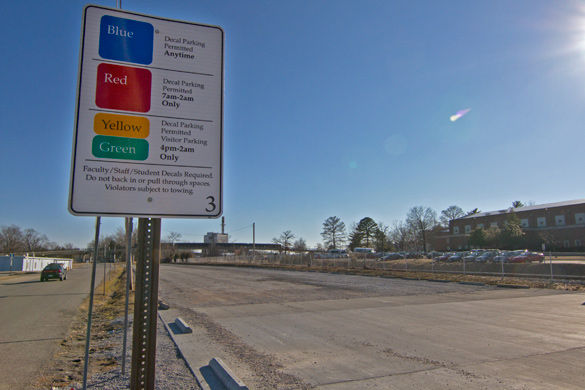Increase in parking to increase decal cost

February 26, 2014
SIU students can look forward to future renovations and more parking availability.
Patti Diggle, coordinator of the Department of Public Safety Parking Division, said there are now 225 new parking spaces on campus. She said the university is pushing to add more red decal parking areas for students.
“We’re not here to stick a spoke in everyone’s wheels,” she said. “We’re trying to maintain some kind of stability, consistency and fairness about parking and that’s why we decided to increase the amount of red parking availability in that area of campus.”
Advertisement
Kevin Bame, vice chancellor for administration and finance, said the university has two new parking lots available for decal sticker users.
Bame said the university converted Lot 13A, which was previously metered, to a red and blue decal sticker lot and added 90 new spaces for students.
Diggle said there are four new handicapped-parking spaces in 13A.
Bame said City Lot 3, located by the blue barracks, is ready for use as well, after being leased from the City of Carbondale. The lease is a two-year agreement for $10,000 a year and consists of 135 parking spaces.
In order to exit Lot 3, one must drive south on Washington Street around the Brush Towers and then north on Logan Drive to intersect Wall Street just south of East Grand.
The university will determine the future of the lot in two years depending on feedback and consistent use from students and faculty.
The university is considering raising the prices of decals to pay for this lease.
Advertisement*
Yellow stickers may increase by $15, making them $40, while red and green may increase by $20, making them $110. Pricing for faculty and staff depends on their salary and decals may increase anywhere from $10 to $55.
The recommendations go into effect July 1 based on the chancellor’s approval. Bame said decal sales account for more than $1 million dollars per year.
Diggle said last year, the school generated nearly $900,000 in decals alone.
Bame said because of the additional spaces, decal revenue is projected to increase by nearly $200,000. He said he expects the revenue to be near $1.2 million this year. The money generated from decals is distributed to different needs within the parking lots, he said.
“We have, what we call, a traffic and parking fund,” he said. “From that, we pay to maintain the lots, do the snow removal of parking lots, pay for exterior lighting and run the street sweeper that we have on campus.”
Diggle said parking decals are always changing. When renovations are complete in Woody Hall, decals will change, as many offices in the old Greek Row relocate there.
“The parking agents every day do lot counts on various lots so we can see what the patterns and trends are. It varies every semester,” she said.
The university is planning renovations to several roads on campus funded by the possible decal price increases.
Bame said the university is working on a design for additions and renovations to the Communications Building. Once completed, Lincoln Drive will be rerouted around the west side of the new structure.
The Capital Development Board will fund the project at a cost of $74 million to the State of Illinois. The blueprint may be complete in 18 months, and construction will begin if the government has bonds available.
“The concept for the building now is to move a little towards the north and a little to the east, which would then encroach Lincoln Drive,” he said. “There is a fair amount of traffic that moves fairly quickly and we think that we can divert some of that around the communications building. It will create more of a pedestrian friendly access to the building. It will create another quad type area.”
While new renovations are on the way, students are still receiving tickets. Diggle said last year, the university generated more than $785,000 in parking fines.
William Recktenwald, representative of the Faculty Senate, said students who think they do not deserve a ticket can appeal to the Traffic & Parking Appeal Board.
The appeal board consists of representatives from the Faculty Senate, the Civil Service Council, Administrative and Professional Staff Council, and the Graduate and Professional Student Council. Recktenwald said in previous years, there has been a representative from the Undergraduate Student Government, but he has not seen one yet this semester.
“It’s very disappointing that the Undergraduate Student Government does not have a regular attendee, considering that most of the tickets we look at are undergraduate students,” he said.
Recktenwald said three of the five members must agree the violation is not ticket-worthy to get a ticket appealed. He said appeals may be emailed or written. The petitioner then appears before the board in one of the three annual meetings in the student center.
“We give people the opportunity to tell their story, to tell why they parked in the wrong place,” he said. “We often consider the fact that people make mistakes.”
About 60 percent of people who say they are going to appear before the board do not show up to the expected meeting, Recktenwald said. He said about half of the people that show up get their tickets dismissed or reduced.
Recktenwald said the most common violation is when students with stickers park in metered lots or 15 minute areas.
Luke Nozicka can be reached at [email protected]
Advertisement







